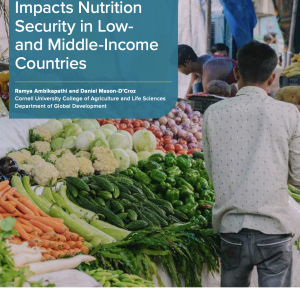
This report commissioned by Farm Journal Foundation explores how climate change is affecting nutrition in low and middle income countries, where citizens tend to have a lower capacity to adapt. It outlines 9 suggestions for the US government to support global nutrition security.
Publisher’s summary
A series of global challenges in the past few years – including the COVID-19 pandemic, regional conflicts, and climate change – has sent the world hurtling in the wrong direction when it comes to food and nutrition security. Today, about 10 percent of the global population experiences hunger, significantly higher than in recent years, and 3 billion people are unable to afford a well-balanced, healthy diet that includes whole grains, fruits, vegetables, and animal-sourced foods. Climate change, in particular, has imposed significant burdens on global nutrition outcomes. The increasing frequency of extreme weather events – including droughts, floods, wildfires, heat waves, and severe storms – has a disproportionate effect on low- and middle-income countries where large proportions of the population rely on agriculture to make a living. Extreme weather can lead to crop failures, pressure from diseases and pests, lost crop and livestock productivity, and lower nutritional value of food – ultimately hurting farmers’ livelihoods and leading to higher costs for consumers. Low- and middle- income countries also often have limited capacity to adapt to climate challenges, due to a lack of safety net programs for low-income households, robust infrastructure, and tools and technologies that would enable farmers to produce good crops even in the face of increasingly difficult conditions. Women are particularly vulnerable to food and nutrition insecurity, as they generally have lower incomes compared with men, and studies show that during times of financial pressure, they often reduce their food intake or skip meals so that other members of their household can eat. High food costs and lost agricultural incomes contribute to increasing rates of malnutrition in all forms, including micronutrient deficiencies, undernutrition, and more recently, overweight and obesity. Children, adolescents, and women who are pregnant or lactating have higher nutrient needs, leaving them especially at risk. Improving nutrition outcomes and shoring up our global food system to deal with climate change will require a whole of society and government approach, to ensure that policy solutions work both for nutrition security as well as the natural environment.
Reference
Ambikapathi.A.& Mason-D’Croz.D.(2024) How climate change impacts nutrition security in low and middle-income countries. Farm Journal Foundation and Cornell College of Agriculture and Life Sciences.
Read more here. See also the TABLE explainer, What is the nutrition transition?












Post a new comment »